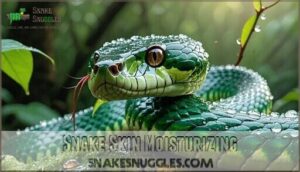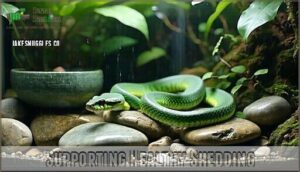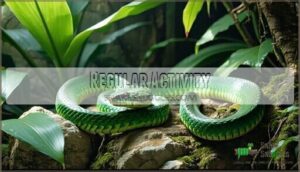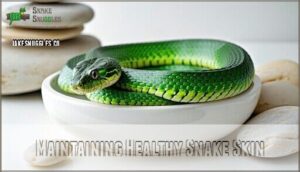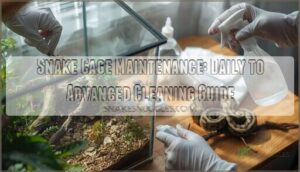This site is supported by our readers. We may earn a commission, at no cost to you, if you purchase through links.
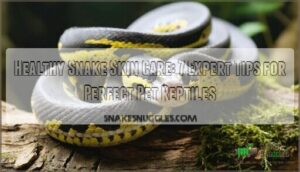 Maintaining healthy snake skin care starts with proper humidity levels between 50-80%, depending on your species.
Maintaining healthy snake skin care starts with proper humidity levels between 50-80%, depending on your species.
You’ll want to provide a humid hide, shallow water dish for soaking, and rough surfaces like cork bark for natural shedding assistance.
Monitor for signs like milky eyes or dull coloration that indicate upcoming sheds, then increase humidity slightly.
Clean substrate prevents bacterial infections, while consistent temperatures support the natural shedding cycle.
Watch for stuck shed around the tail, eyes, or nose – these areas need extra attention.
Your snake’s skin tells a story about its overall health, from vibrant colors to smooth texture.
The secret lies in understanding what those subtle changes really mean, and how they relate to the natural shedding cycle.
Table Of Contents
- Key Takeaways
- Snake Plant Air Benefits
- Snake Skin Moisturizing
- Shedding Process Explained
- Supporting Healthy Shedding
- Snake Skin Health Indicators
- Common Snake Skin Issues
- Maintaining Healthy Snake Skin
- Frequently Asked Questions (FAQs)
- How to care for snake skin?
- How to keep snake skin at home naturally?
- Can you help a snake peel its skin?
- What causes snake skin to appear dull?
- How do temperature changes affect snake skin?
- Can nutritional deficiencies impact skin health?
- What snake skin problems require veterinary care?
- How often should snake enclosures be cleaned?
- Conclusion
Key Takeaways
- You’ll maintain optimal humidity levels between 50-80% using humid hides, water dishes, and regular misting to support healthy shedding cycles and prevent skin problems.
- You’ll create a clean environment by spot-cleaning weekly, deep-cleaning monthly with reptile-safe products, and choosing proper substrates like aspen shavings to prevent infections and parasites.
- You’ll monitor your snake’s shedding process by watching for milky eyes and dull coloration, then increasing humidity slightly and providing rough surfaces for natural shed assistance.
- You’ll recognize health indicators like clear eyes, regular activity, and consistent eating habits while watching for warning signs like stuck shed, abscesses, or parasites that require veterinary care.
Snake Plant Air Benefits
You’ll find that snake plants work as natural air purifiers, removing harmful toxins like formaldehyde and benzene that can irritate your pet snake’s sensitive skin.
These green allies also release oxygen at night and boost humidity levels, creating the perfect environment for healthy scales and smooth shedding cycles, making them a great addition to your pet’s space with their ability to act as natural air purifiers and release oxygen.
Removing Toxins
Snake plants work like nature’s air filters, tackling formaldehyde removal and benzene elimination with impressive efficiency.
Your snake’s scales deserve nature’s strongest defenders – powerful plants that filter toxins while you sleep.
These green powerhouses boost indoor air quality by trapping volatile organic compounds (VOCs) and environmental toxins that sneak into your home.
Their large leaves catch dust particles while increasing humidity naturally, creating a holistic health boost for your space, and acting like a natural air filter for indoor air quality.
Improving Skin Health
Indoor humidity from snake plants works like a natural skin spa for you and your reptile.
Their transpiration creates moisture that prevents dryness while cleaner air reduces pollutants settling on skin surfaces.
This environmental boost supports your snake’s natural shedding process and minimizes breakouts for everyone in the household.
Think of it as dietary influence for your home’s atmosphere—supplementation options that actually work without expensive gadgets or constant maintenance.
These plants also offer significant air purification benefits.
Reducing Irritation
Your snake’s environment directly affects their skin comfort.
A comfortable snake needs a clean, stable home environment to thrive and maintain healthy skin.
Poor substrate choices like cedar shavings or rough gravel can cause substrate irritation and abrasions.
Chemical exposure from harsh cleaners creates handling sensitivity, while dirty enclosures breed snake mites and infections.
Sharp decorations become enclosure hazards, leading to cuts that invite snake skin problems.
Choose smooth substrates and reptile-safe products to prevent snake skin irritation. Adding plants like snake plants can also help with air quality improvement to improve overall environment.
Snake Skin Moisturizing
Your snake’s skin needs moisture to stay healthy and flexible, just like how your own skin benefits from lotion after a hot shower.
Proper hydration prevents painful shedding problems and keeps those beautiful scales looking their best, which is crucial for the overall health and appearance of your snake, highlighting the importance of moisture.
Importance of Hydration
Your snake’s skin health depends on proper hydration – think of it as their natural armor that needs constant moisture to stay flexible.
Without adequate water access and humidity levels, your pet faces serious dehydration risks that can turn shedding into a nightmare.
Essential Hydration Benefits:
- Prevents dysecdysis – Proper snake skin hydration keeps old skin loose and easy to remove
- Maintains scale flexibility – Well-hydrated reptile skin hydration prevents cracking and infections
- Supports the snake shedding process – Adequate moisture guarantees smooth, complete sheds
- Reduces stress – Comfortable humidity levels keep your snake calm during vulnerable periods
- Acts as shedding aid – Proper water access helps snakes naturally remove old skin layers
Methods of Moisturizing
You’ll find several effective misting techniques for reptile skin hydration that keep your scaly friend comfortable.
Spray bottles work perfectly for quick moisture boosts, while moisture chambers with damp sphagnum moss create humidity havens.
Soaking methods involve shallow warm water baths lasting fifteen minutes.
Commercial reptile moisturizers offer convenience, though natural oil application using grapeseed or coconut oils works wonders when applied sparingly along scale direction.
Maintaining proper humidity is key to preventing common skin issues and supporting healthy shedding with natural oil application.
Frequency of Moisturizing
Your snake’s moisturizing needs aren’t one-size-fits-all.
Most reptiles thrive with weekly sessions, but several factors influence this routine:
- Seasonal Adjustments – Winter’s dry air demands twice-weekly care
- Species Differences – Desert snakes need less; tropical species require more
- Age Influence – Young snakes shed frequently, needing extra hydration
Monitor your pet’s skin condition and adjust accordingly.
Enclosure type, individual needs, and environmental humidity all impact your snake skin care routine.
Remember, consistency beats perfection in maintaining proper hydration.
Shedding Process Explained
Understanding your snake’s shedding process helps you provide better care during this natural cycle.
When snakes shed their skin through ecdysis, they’re literally growing out of their old skin to make room for their expanding bodies, which is a key part of their development and requires careful observation to ensure a healthy shedding process.
Ecdysis and Growth
Every snake undergoes ecdysis, the fascinating process where they literally outgrow their old skin.
This snake skin shedding cycle happens because your pet’s skin layers can’t stretch indefinitely during growth spurts.
Young snakes shed more frequently than adults, with shedding frequency decreasing as they mature.
The ecdysis stages begin when new skin forms underneath, causing that telltale dull appearance.
Understanding your snake’s natural snake shedding cycle helps you provide better post-shed care.
Environmental Factors
Beyond just providing shelter, your snake’s environment acts like a symphony conductor, orchestrating every aspect of healthy skin development.
Each element works together to create the perfect conditions for natural shedding cycles.
Here are four critical environmental factors that’ll make or break your snake’s skin health:
- Habitat Cleanliness – Clean enclosures prevent 90% of skin infections by eliminating harmful bacteria
- Temperature Gradient – Proper heat zones boost metabolism and cellular regeneration for stronger scales
- Substrate Selection – The right bedding provides natural rubbing surfaces while preventing cuts and abrasions
- Enclosure Size – Adequate space reduces stress hormones that interfere with healthy shedding patterns
Humidity and Temperature
Creating ideal habitat humidity and temperature control requires understanding how these factors work together during shedding.
You’ll need humidity gradients between 50-80%, with basking spots reaching species-specific temperatures.
Microclimates within the enclosure allow your snake to self-regulate, moving between areas as needed.
Temperature regulation affects metabolism and shedding frequency, while seasonal adjustments mimic natural cycles.
Consider specialized reptile humidifiers to maintain ideal conditions.
Monitor both elements closely—they’re your snake’s best friends for successful ecdysis, ensuring the right balance of humidity and temperature.
Supporting Healthy Shedding
You’ll want to create the perfect environment for your snake’s shedding process by maintaining proper humidity levels and minimizing stress factors.
Think of it like setting up a spa day for your scaly friend – they need the right conditions to slip out of their old skin smoothly and reveal those gorgeous new scales underneath, which is crucial for a healthy shedding process and can be considered a stress-free environment.
Providing Humidity
Boost your snake’s shedding success by maintaining ideal habitat humidity between 50-60%.
Humidity monitoring becomes your best friend during this vital time, while proper enclosure design with water sources and smart substrate choice creates the perfect environment.
Remember that snakes undergo ecdysis and growth, a natural shedding process.
Essential humidity boosters:
- Humid hides with damp sphagnum moss – Your snake’s personal spa retreat
- Moisture chamber placement – Strategic positioning near your pet’s favorite spots
- Regular misting schedules – Gentle spray bottles work wonders for snake skin moisture
Reducing Stress
Stress can make your snake’s skin problems worse, so creating a stressfree environment is essential.
Keep Handling Techniques gentle and minimize disruptions during shedding.
Maintain Consistent Routines for feeding and cleaning, while ensuring Secure Hiding spots are available.
A Quiet Environment with proper Enclosure Enrichment helps reduce stress factors that could stress your snake and interfere with healthy shedding cycles.
Monitoring Health
You’ll know your snake’s thriving by watching their activity levels and eating habits.
Healthy snakes move around regularly, maintain alert snake behavior, and show consistent waste regularity.
Keep tabs on their habitat conditions – proper temperature and humidity directly impact snake skin health.
If you notice changes in appetite, lethargy, or unusual snake skin conditions, don’t hesitate to contact veterinary care for professional reptile health assessment.
Snake Skin Health Indicators
You’ll know your snake is healthy by checking for clear, bright eyes and clean nostrils that aren’t blocked or runny.
A healthy snake also maintains regular activity levels, moves around its enclosure normally, and keeps up consistent eating habits without refusing meals for extended periods, which is a key indicator of its overall health.
Clear Eyes and Nose
Watching your snake’s facial features tells you everything about their overall health.
Clear, bright eyes and clean nostrils signal a thriving reptile that’s breathing easily and seeing clearly.
Here’s what healthy facial features look like:
- Eye Clarity – Bright, alert eyes without cloudiness or milky film (except during normal shedding)
- Nasal Discharge – Completely clear nostrils with no mucus, blood, or crusty buildup around openings
- Breathing Sounds – Silent, effortless breathing without wheezing, clicking, or mouth-breathing patterns
- Facial Swelling – Even facial contours without puffiness, lumps, or asymmetrical bulging areas
Watch for Behavioral Changes that accompany facial issues – lethargy often pairs with respiratory problems, while retained eye caps cause navigation difficulties.
Regular Activity
A healthy snake moves with purpose and confidence around its enclosure.
You’ll notice your reptile actively exploring different areas, showing consistent Activity Levels that indicate strong Muscle Tone and overall wellness.
Watch for regular Enclosure Exploration patterns – snakes should investigate their habitat, use hiding spots, and position themselves properly for thermoregulation.
Sudden Behavioral Changes like lethargy or excessive hiding often signal Exercise Needs aren’t being met or underlying health issues affecting reptile skin health.
Healthy Eating Habits
Your snake’s appetite tells a story about their overall health, and consistent eating habits reflect excellent snake skin care.
Proper prey nutrition directly supports healthy snake skin through essential vitamins and minerals that maintain scale integrity.
Here’s what to monitor for ideal snake health:
- Feeding frequency – Adult snakes typically eat every 1-2 weeks, while juveniles need weekly meals to support growth and skin development
- Prey nutrition – Whole prey provides complete nutrition, including calcium and vitamins that promote strong, flexible scales and proper hydration
- Dietary variety – Rotating between appropriate prey types (mice, rats, or species-specific food) guarantees balanced nutrition for snake veterinary care
- Obesity risks – Overfeeding leads to health issues that compromise skin quality, so stick to appropriate prey sizes and supplementation guidelines
To prevent nutritional deficiencies, verify a proper calcium to phosphorus ratio.
Common Snake Skin Issues
You’ll encounter several skin problems that can seriously affect your snake’s health if left untreated.
Understanding these common issues helps you spot trouble early and take action before minor problems become major headaches.
Abscesses and Infections
Bacterial infections lurk like unwelcome guests when wounds meet dirty substrates.
Identifying Abscesses requires spotting localized swelling filled with pus—your snake’s SOS signal.
Treating Infections demands immediate Veterinary Care and Antibiotic Use to prevent septicemia.
Preventing Abscesses starts with spotless enclosures and proper substrate choices. Don’t let bacterial dermatitis crash your reptile’s party—clean environments keep these unwanted microbes at bay.
Blister Disease
Moisture becomes your snake’s enemy when blister disease strikes.
This painful condition develops rapidly in damp, dirty environments, creating fluid-filled blisters that can become life-threatening infections.
Key blister disease facts:
- Causes: Soiled substrates and excessive humidity create perfect breeding grounds
- Symptoms: Pink, red, or pus-filled blisters appear on belly scales
- Prevention: Keep enclosures dry and clean with proper drainage
- Treatment: Long-term antibiotics and environmental correction are essential
- Prognosis: Recovery takes months, requiring multiple sheds to heal completely
Parasites and Mites
Beyond bacterial infections, tiny invaders like snake skin mites and ticks can wreak havoc on your pet’s health.
These sneaky parasites are more common than you’d think, affecting up to 38% of captive snakes.
| Parasite Type | Identification |
|---|---|
| Snake Mites | Tiny black/red specks around eyes |
| Ticks | Larger, swollen bumps on skin |
| Internal Parasites | Weight loss, poor appetite |
| Mixed Infections | Multiple symptoms present |
Treatment Options vary from oral medications like afoxolaner to Veterinary Care for severe cases.
Mite Prevention starts with proper Enclosure Cleaning and quarantining new arrivals.
You’ll spot these troublemakers by watching for excessive soaking behavior and ash-colored droppings on scales.
Effective snake mite treatments are readily available for reptile owners.
Maintaining Healthy Snake Skin
You’ll want to focus on three key areas to keep your snake’s skin in top condition: maintaining a spotless habitat, choosing the right substrate, and staying on top of hydration needs.
Think of it like creating a spa environment for your scaly friend—clean surroundings prevent infections, proper bedding protects delicate skin, and consistent moisture levels guarantee your snake can shed like a champion.
Clean Environments
Keep your enclosure spotless, and you’ll prevent 90% of snake skin infections before they start.
Regular cleaning the enclosure means removing waste immediately, disinfecting surfaces weekly with reptile-safe cleaners, and maintaining proper water quality.
Focus on mold prevention by ensuring adequate ventilation and promptly addressing moisture buildup.
Clean substrates prevent snake skin mites and ticks from establishing colonies in your pet’s home, which is crucial for proper water quality and overall health, including the prevention of infections through reptile-safe cleaners.
Proper Substrate
Your snake’s foundation matters more than you might think.
Choose aspen shavings or cypress mulch over pine, which can irritate sensitive skin. These substrate materials provide natural burrowing needs while controlling humidity levels effectively.
Replace substrate monthly, spot-cleaning weekly to prevent bacterial buildup. Avoid cedar shavings and newspaper – they’re either toxic or harbor moisture that breeds problems.
Some keepers prioritize odor control considerations for a fresher enclosure.
Regular Hydration Checks
You’ll want to check your snake’s water availability daily, watching for dehydration signs like sunken eyes or wrinkled skin.
Test skin turgor by gently pinching—healthy skin snaps back quickly.
Monitor drinking behavior and verify fresh water’s always accessible.
Regular hydration assessment prevents shedding problems and maintains prime reptile skin care, keeping humidity levels stable for your pet’s wellbeing, ensuring daily checks are crucial.
Frequently Asked Questions (FAQs)
How to care for snake skin?
Maintaining moisture matters most for snake skin health.
You’ll need to monitor humidity levels, provide water bowls, and create humid hides with damp moss.
Mist regularly but avoid over-moisturizing to prevent infections.
How to keep snake skin at home naturally?
Humidity plays a vital role in your snake’s skin health, so you’ll want to maintain proper moisture levels through misting, humid hides, and shallow water dishes for natural hydration.
Can you help a snake peel its skin?
You can assist your snake’s shedding by increasing humidity with a humid hide, providing rough surfaces for rubbing, and offering warm water soaks.
Don’t pull stuck skin directly—gentle warm baths usually help stubborn pieces come off naturally during the process, which is an important part of the shedding process.
What causes snake skin to appear dull?
Picture your ball python’s eyes turning cloudy blue like frosted glass before shedding—that’s normal dulling.
You’ll notice skin appears lackluster when fluid builds between old and new layers, signaling the natural ecdysis process is starting.
How do temperature changes affect snake skin?
Temperature fluctuations trigger shedding cycles, affect skin flexibility, and can cause retained shed if too low.
You’ll notice your snake’s skin becomes less pliable in cooler temps, while proper warmth keeps scales healthy and promotes complete shedding, which is crucial for the snake’s overall health, particularly in relation to skin flexibility.
Can nutritional deficiencies impact skin health?
Yes, nutritional deficiencies definitely impact your snake’s skin health.
Poor diet leads to dull scales, difficult shedding, and increased infection risk.
You’ll notice vitamin A deficiency causes retained sheds, while inadequate protein affects scale development and overall skin integrity, leading to issues such as dull scales and difficult shedding.
What snake skin problems require veterinary care?
Just like finding the right puzzle piece, you’ll know when snake problems need a vet’s expertise.
Seek professional care for abscesses, blister disease, bloating, persistent parasites, respiratory infections, or retained shed causing circulation issues.
How often should snake enclosures be cleaned?
You’ll want to spot-clean your snake’s enclosure weekly, removing waste and uneaten food immediately. Deep clean the entire habitat monthly with reptile-safe disinfectants to prevent infections and maintain proper hygiene.
Conclusion
Practice makes perfect, and healthy snake skin care requires consistent attention to detail.
You’ve learned the essential elements: proper humidity levels, clean environments, and recognizing shedding signs.
By monitoring your snake’s skin condition, providing adequate moisture, and maintaining ideal temperatures, you’ll prevent common issues like stuck shed and infections.
Remember, your snake’s vibrant appearance reflects your dedication to creating the perfect habitat, which guarantees your reptile companion thrives with beautiful, healthy skin throughout its life, thanks to these expert techniques.

